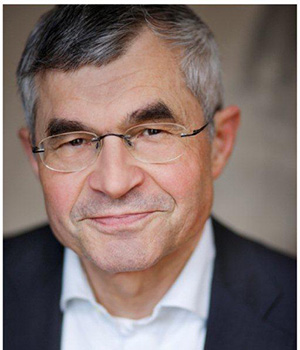Guidelines
Topical social court decisions
Various inorganic dusts initiate inflammatory and fibrotic lung processes. Diagnosis of relatively frequent pneumoconioses such as silicosis or asbestosis with dominating pictures, i. e. with its predominant rounded or irregular opacities located especially in the upper and lower lung fields, respectively, is mostly not difficult. However, rarely exposure to a single agent exists. Rather, mixed dust exposures occurring at the same time or in the follow-up have to be taken into consideration. It is also important that during the working life, changes of working processes and used raw materials as well as changes of jobs are associated with variations of type and intensity of exposures. This heterogenicity of exposures and of the associated intrapulmonary depositions result in variations of the pulmonary structural changes, i. e. more or less modifications of the pictures of pneumoconioses as described being typical in textbooks. This is associated with diagnostic difficulties. This publication includes 5 case reports; all of them were initially diagnosed as idiopathic pulmonary fibrosis, but a detailed workup of the author, mostly during social court litigations, showed that mixed dust pneumoconioses were the most likely diagnoses.
Publicationen
Spotlight allergic alveolitis
Occupational asthma - Berufsasthma
Baur, X. (2013). "A compendium of causative agents of occupational asthma." J Occup Med Toxicol 8(1): 15.
Baur, X. (2010). Mechanisms of allergic occupational asthma. Occupational asthma. T. Sigsgaard and D. Heederik. Basel, Birkhäuser: 111-140.
Baur, X. (2011). "[Obstructive airway disorders representing occupational diseases]." Pneumologie 65(11): 654-661.
Baur, X. (2013 ). Crashkurs Lungenfunktionsprüfung. München-Deisenhofen, Dustri-Verlag.
Baur, X. and P. Bakehe (2013). "Allergens causing occupational asthma: an evidence-based evaluation of the literature." Int Arch Occup Environ Health.
Baur, X., P. Bakehe and H. Vellguth (2012). "Bronchial asthma and COPD due to irritants in the workplace - an evidence-based approach." J Occup Med Toxicol 7(1): 19.
Baur, X. and L. T. Budnik (2011). Isocyanatbedingte Gesundheitsgefahren. Handbuch der Arbeitsmedizin. S. Letzel and D. Nowak. Landsberg, Ecomed: 1-10.
Baur, X. (2005). "Enzymes as occupational and environmental respiratory sensitisers." Int Arch Occup Environ Health 78(4): 279-286.
Baur, X. (2006). "[Working place related obstructive airway diseases]." Pneumologie 60(5): 305-314; quiz 315-319.
Baur, X. (2010). Mechanisms of allergic occupational asthma. Occupational asthma. T. Sigsgaard and D. Heederik. Basel, Birkhäuser: 111-140.
Baur, X. (2011). "[Bronchial Challenge Tests]." Pneumologie 65(6): 340-346.
Baur, X. (2011). "[Obstructive airway disorders representing occupational diseases]." Pneumologie 65(11): 654-661.
Baur, X. (1987). "Kritische Anmerkungen zur Diagnostik des Isocyanat-Asthmas." Arbeitsmed Sozialmed Präventivmed 22(12): 291-293. Baur, X. (2005). "Enzymes as occupational and environmental respiratory sensitisers." Int Arch Occup Environ Health 78(4): 279-286.
Baur, X. (2006). "[Working place related obstructive airway diseases]." Pneumologie 60(5): 305-314; quiz 315-306.
Baur, X. (2007). "Evidence for allergic reactions in isocyanate asthma." J Allergy Clin Immunol 119(3): 757-758; author reply 758.
COPD
Dement, J., L. Welch, K. Ringen, P. Quinn, A. Chen and S. Haas (2015). "A case-control study of airways obstruction among construction workers." Am J Ind Med 58(10): 1083-1097.
Bergdahl, I. A., K. Toren, K. Eriksson, U. Hedlund, T. Nilsson, R. Flodin and B. Jarvholm (2004). "Increased mortality in COPD among construction workers exposed to inorganic dust." Eur Respir J 23(3): 402-406.
Bruske, I., E. Thiering, J. Heinrich, K. M. Huster and D. Nowak (2014). "Respirable quartz dust exposure and airway obstruction: a systematic review and meta-analysis." Occup Environ Med 71(8): 583-589.
Baur, X. and U. Latza (2004). "[COPD due to occupational exposure to silica dust (SiO2, especially quartz)]." Pneumologie 58(4): 201-203.
Baur, X. (2011). "[Obstructive airway disorders representing occupational diseases]." Pneumologie 65(11): 654-661.
Baur, X., P. Bakehe and H. Vellguth (2012). "Bronchial asthma and COPD due to irritants in the workplace - an evidence-based approach." J Occup Med Toxicol 7(1): 19.
Collegium, Ramazzini (2016) A new approach to the control of chronic obstructive pulmonary disease (COPD) http://www.collegiumramazzini.org/download/19_NineteenthCRStatement(2016).pdf.
Cullinan, P. (2012). "Occupation and chronic obstructive pulmonary disease (COPD)." Br Med Bull 104: 143-161.
Labrecque, M. (2012). "Irritant-induced asthma." Curr Opin Allergy Clin Immunol 12(2): 140-144.
Malo, J. L., J. L'Archeveque, L. Castellanos, K. Lavoie, H. Ghezzo and K. Maghni (2009). "Long-term outcomes of acute irritant-induced asthma." Am J Respir Crit Care Med 179(10): 923-928.
Welding fumes
Merget R, Baur X, für die AG Atemwege/Lunge der DGAUM. Diagnostik und Beurteilung obstruktiver Atemwegserkrankungen durch chemisch-irritativ oder toxisch wirkende Stoffe (Berufskrankheit Nr. 4302 BKV). Arbeitsmed Sozialmed Umweltmed 2008;43:516-520
Mapp CE, Boschetto P, Maestrelli P, Fabbri LM. Occupational asthma. Am J Respir Crit Care Med 2005;172:280-305
Langley RL. Fume fever and reactive airways dysfunction syndrome in a welder. South Med J. 1991;84:1034-1062
Schneider J Lungenfunktionseinschränkungen bei Schweißern Arbeitsmed.Sozialmed.Umweltmed. 2010 (45) 12–18
Baur, X., Butz, M., Latza, U. (2003) Arbeitsbedingte Erkrankungen der Lungen und derAtemwege sowie Neoplasien. Deutsches Ärzteblatt 100:2658-2665
Latza U, Cordula Bittner, Baur X Berufsbedingte, allergische und irritative obstruktive Atemwegserkrankungen im gewerblichen Bereich: Geschlechtssensitive Identifikation von Präventionspotenzialen. ErgoMed Ausgabe: 01/2007
Baur X, Heutelbeck A, Kujath P, Stahlkopf H Prävention arbeitsbedingter obstruktiver AtemwegserkrankungenInterdisziplinäre S1-Leitlinie der Deutschen Gesellschaft für Arbeitsmedizin und Umweltmedizin. Pneumologie 2011; 65: 263–282
Pneumoconioses Silicosis/Asbestos-related diseases - Silikose/Asbestbedingte Erkrankungen
Baur, X., M. Clasen, A. Fisseler-Eckhoff, M. Heger, K. G. Hering, K. Hofmann-Preiss, D. Kohler, A. Kranig, T. Kraus, S. Letzel, V. Neumann, A. Tannapfel, J. Schneider, H. Sitter, H. Teschler, T. Voshaar and A. Weber (2011). "[Diagnostics and expert opinion of asbestos-induced occupational diseases]." Pneumologie 65(3): e1-47.
Baur, X., M. Heger, D. Kohler, A. Kranig, S. Letzel, G. Schultze-Werninghaus, A. Tannapfel, H. Teschler, T. Voshaar, M. R. Bohle, N. Erlinghagen, K. G. Hering, K. Hofmann-Preiss, T. Kraus, R. Merget, G. Michaely, V. Neumann, D. Nowak, I. Ozbek, H. J. Piasecki and N. Staubach-Wicke (2008). "[Diagnostics and expert opinion in the occupational disease No. 4101 silicosis (including coal worker's pneumoconiosis). Guideline (S2; AWMF) of the Deutsche Gesellschaft fur Pneumologie und Beatmungsmedizin and the Deutsche Gesellschaft fur Arbeitsmedizin und Umweltmedizin]." Pneumologie 62(11): 659-684. http://www.awmf.org/uploads/tx_szleitlinien/020-010_S2_Diagnostik_und_Begutachtung_der_Berufskrankheit_Nr._4101_Quarzstaublungenerkrankung__Silikose_abgelaufen.pdf
Empfehlung für die Begutachtung von Quarzstaublungenerkrankungen (Silikosen)
– Bochumer Empfehlung –
http://publikationen.dguv.de/dguv/pdf/10002/bochum_neu.pdf
Abraham, J. L. (2006). Analysis of fibrous and non-fibrous particles, Lippincott Williams and Wilkins.
Baur X., J. Schneider, H.-J. Woitowitz: Diagnostik und Begutachtung asbestbedingter Berufskrankheiten. Kurzdarstellung der neuen S2k-Leitlinie mit Kommentierung und Fallbeispielen. Dtsch. Med. Wschr. 136 (2011) 2319 – 2324
Rödelsperger, K. und H.-J. Woitowitz: Commentary regarding the article by Fischer et al.: Fibre years, pulmonary asbestos burden and asbestosis. Int. J. Hyg. Environ. Health 205, 245-248 (2002).
Letter to the Editor. Int. J. Hyg. Environ. Health 206, 245-247 (2003)
Woitowitz, H.-J., K. Rödelsperger, H. Bödeker, B. Brückel und V. Gosch: Biomonitoring nach Asbestfaserstaub-Einwirkung: Lichtmikroskopie versus Elektronenmikroskopie. Arbeitsmed. Sozialmed. Präventivmed 26: (1991) 219-224
Hauser-Heidt G, R. Arhelger, K.D. Hering, H.J. Woitowitz, J. Schneider: Validitätsmaße des HRCT und des Röntgen-Übersichtsbilds bei Patienten mit Asbestfaserstaubverursachten Erkrankungen der Lunge und der Pleura (BK-Nr. 4103) 47. Jahrestagung der Dtsch. Ges. Arbeitsmed. in Mainz, DGAUM, Geschäftsstelle Lübeck (2007) 618-620
Woitowitz, H.-J., J. Manke, B. Brückel und K. Rödelsperger: Asbestkörperchen als Beweismittel einer beruflichen Gefährdung durch Weißasbest (Chrysotil)? Zbl. Arbeitsmed. 36: (1986) 354-364
Baur X, J. Schneider, H-J. Woitowitz, M. Velasco Garrido: Gibt es Unterschiede in den gesundheitsschädlichen Wirkungen von Chrysotil- und Amphibolasbest? Pneumologie 2012; 66:497-506 Wilken, D., M. Velasco Garrido, U. Manuwald and X. Baur (2011). "Lung function in asbestos-exposed workers, a systematic review and meta-analysis." J Occup Med Toxicol 6: 21.
Mixed dust pneumoconioses
Shida H, Chiyotani K, Honma K et-al. Radiologic and pathologic characteristics of mixed dust pneumoconiosis. Radiographics. 1996;16 (3): 483-98. doi:10.1148/radiographics.16.3.8897618 - Pubmed citation
Honma K, Abraham JL, Chiyotani K et-al. Proposed criteria for mixed-dust pneumoconiosis: definition, descriptions, and guidelines for pathologic diagnosis and clinical correlation. Hum. Pathol. 2005;35 (12): 1515-23. Pubmed citation
International Classification of HRCT for Occupational and Environmental Respiratory Diseases. Springer. ISBN:4431239243. Read it at Google Books - Find it at Amazon
Vallurupalli S, Chawla K, Kupfer Y et-al. Mixed dust pneumoconiosis occurring in an unusual setting. BMJ Case Rep. 2013;2013 (dec02 1): . doi:10.1136/bcr-2013-200976 - Pubmed citation
Akira M. Uncommon pneumoconioses: CT and pathologic findings. Radiology. 1995;197 (2): 403
Chong S, Lee KS, Chung MJ et-al. Pneumoconiosis: comparison of imaging and pathologic findings. Radiographics. 26 (1): 59-77. doi:10.1148/rg.261055070
Mcloud TC. Occupational lung disease. Radiol. Clin. North Am. 1991;29 (5): 931-41. - Pubmed citation
Kim KI, Kim CW, Lee MK et-al. Imaging of occupational lung disease. Radiographics. 2001;21 (6): 1371-91. Radiographics (full text) - Pubmed citation
Farzaneh MR, Jamshidiha F, Kowsarian S. Inhalational lung disease. Int J Occup Environ Med. 2012;1 (1): 11-20.
Arakawa H, Johkoh T, Honma K, Saito Y, Fukushima Y, Shida H, et al. Chronic interstitial pneumonia in silicosis and mix-dust pneumoconiosis: its prevalence and comparison of CT findings with idiopathic pulmonary fibrosis. Chest. 2007 Jun;131(6):1870-6. PubMed PMID: 17400659.
Short S, Petsonk EL. 1996. Nonfibrous inorganic dusts. In: Occupational and Environmental Respiratory Disease (Harber P, Shenker MB, Balmes JR, eds). 1st ed. St Louis:Mosby-Year Book, Inc., 345–361.
Kevin O. Leslie and Mark R. Wick, Practical Pulmonary Pathology: A Diagnostic Approach 2nd edition published by Elsevier 2011
Raghu, G., et al. 2011 An official ATS/ERS/JRS/ALAT statement: idiopathic pulmonary fibrosis: evidence-based guidelines for diagnosis and management. Am J Respir Crit Care Med 183(6):788-824.
 Xaver Baur, MD, has devoted much of his academic career to broad questions of occupational and environmental medicine.
Xaver Baur, MD, has devoted much of his academic career to broad questions of occupational and environmental medicine.





